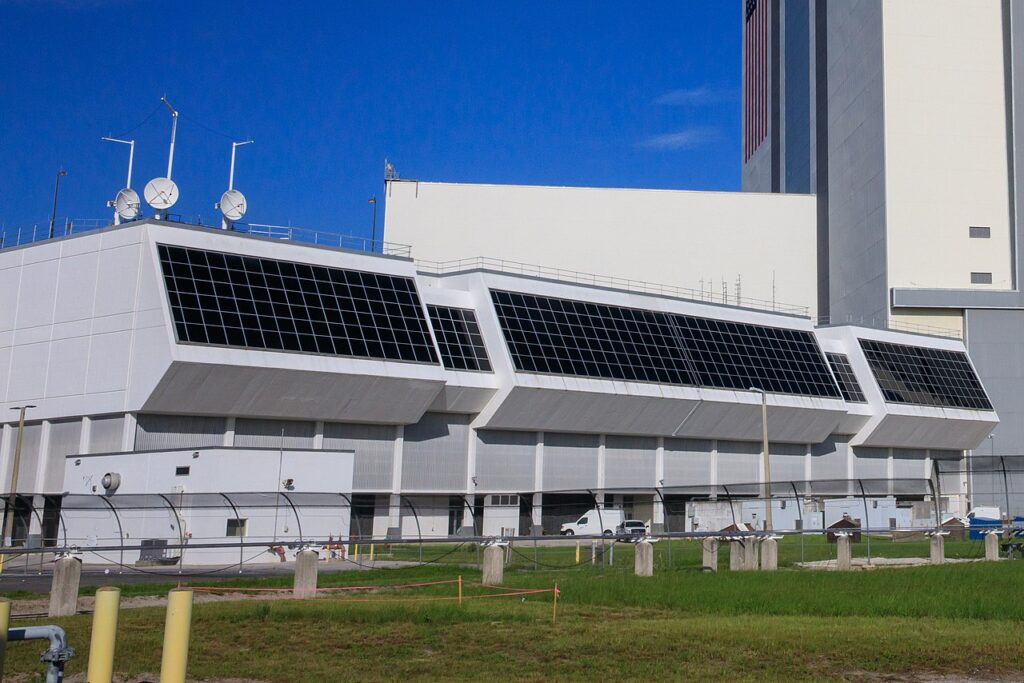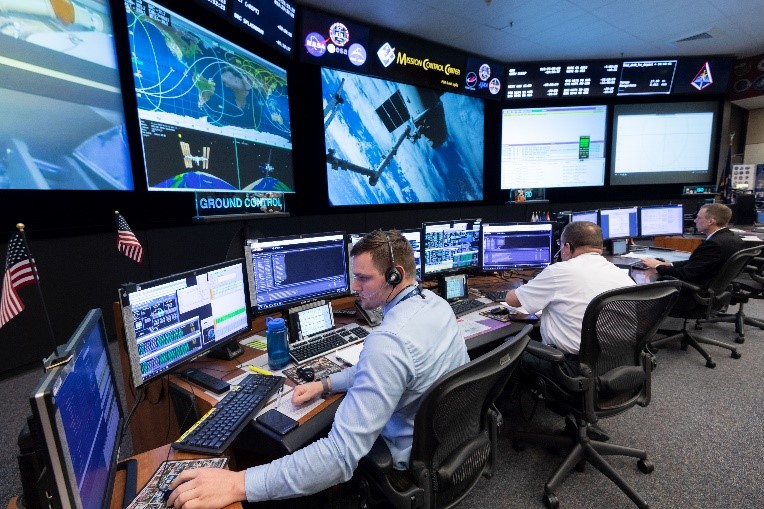NASA mission management
Launch Control Center (LCC)
- John F. Kennedy Space Center (KSC, Titusville, Florida)
- Launch Director (LD). Polls Go/ No go for Launch.
- Control Rooms (Firing rooms).
- Until cleared tower.
The Rocco A. Petrone Launch Control Center (commonly known as just the Launch Control Center or LCC) is a four-story building at NASA’s Kennedy Space Center on Merritt Island, Florida, used to manage launches of launch vehicles from Kennedy Space Center Launch Complex 39. Attached to the southeast corner of the Vehicle Assembly Building, the LCC contains offices; telemetry, tracking, and instrumentation equipment; and firing rooms.
LCC has conducted launches since the unmanned Apollo 4 (Apollo-Saturn 501) launch on November 9, 1967. LCC’s first launch with a human crew was Apollo 8 on December 21, 1968. NASA’s Space Shuttle program also used LCC. NASA has renovated the center for the upcoming Space Launch System (SLS) missions, which are scheduled to begin in 2022 with Artemis 1. In February 2022, the center was renamed after former launch director Rocco A. Petrone.
Mission Control Center (MCC)
- Johnson Space Center (JSC, Houston, Texas):
- When cleaded Tower.
After liftoff, responsibility is handed over to NASA’s Mission Control Center in Houston, Texas (abbreviated MCC-H, full name Christopher C. Kraft Jr. Mission Control Center), at the Lyndon B. Johnson Space Center. NASA’s Mission Control Center in Houston also manages the U.S. portions of the International Space Station (ISS).
MCC is comprised of several flight control rooms (FCR), including FCR-1, FCR-2 and the Red, White and Blue FCRs.
The teams that will operate and monitor the flight around the clock from the White Flight Control Room at Johnson:
Flight Director (Flight)
A graphic of the console positions in White Flight Control Room in mission control. The flight director leads the team of flight controllers, research and engineering experts, and support personnel, making real-time decisions for Orion’s trip around the Moon and back. The position is responsible for mission execution and all commands and troubleshooting that occur during the mission between booster ignition as the SLS rocket lifts off the launch pad, through powering down the Orion spacecraft after splashdown in the Pacific Ocean and handing over responsibility of the spacecraft to the recovery team. The flight director is located near the middle of the room for optimal coordination with the other positions.
Booster Officer (Booster)
The booster officer monitors the performance of the SLS rocket’s solid rocket boosters, core stage, and Interim Cryogenic Propulsion Stage (ICPS) from liftoff through the Trans Lunar Injection (TLI) burn that will send Orion out of Earth’s orbit and toward the Moon, to ensure the rocket’s propulsion system is working as expected.
Command and Data Handling Officer (C&DH)
In the third row, the command and data handling officer monitors the overall health of the Orion spacecraft’s avionics systems and manages its computer systems, software, and data. The C&DH officer will be responsible for crew display interfaces on the spacecraft when astronauts fly in Orion beginning with Artemis II.
Control Officer (Control)
The control officer is responsible for managing the guidance and control of the SLS rocket’s solid rocket boosters, core stage, and ICPS engine from liftoff through the TLI burn.
Emergency, Environmental, and Consumables Officer (EECOM)
The emergency, environmental, and consumables officer reports any issues, such as atmospheric and cooling parameters, to the flight director, manages environmental control and life support systems and emergency procedures. Even though astronauts are not aboard Artemis I, the EECOM will monitor and control thermal control subsystems. The officer is also responsible for integrated team responses to potential emergencies like a leak or toxic atmosphere inside the cabin, or cooling loss issues.
Flight Activities Officer (FAO)
The flight activities officer leads the preparation of the timeline for the flight plan to meet mission objectives. The FAO also will manage coordination of real-time changes in the flight plan and future crew activities once astronauts fly inside Orion.
Flight Dynamics Officer (FDO)
The flight dynamics officer monitors trajectories for Orion during all phases of the mission, including launch, in distant retrograde orbit around the Moon, and in possible abort scenarios during ascent.
Flight Operations Directorate (FOD)
Seated in the back of the room, the flight operations directorate position is a senior manager who helps relay information between the flight control team and relevant managers and leaders within NASA. The console position will be occupied during dynamic phases of flight, including launch, major burns, and re-entry.
Ground Control Officer (GC)
The ground control officer is responsible for the operation of all systems in mission control necessary to perform planning, training, testing, execution, and evaluation of the mission. GC also is responsible for maintaining communications between the Orion spacecraft and the MCC through the Near-Earth and Deep Space Networks.
Guidance, Navigation, and Control (GNC)
The guidance, navigation, and control officer operates Orion’s navigation and flight control software during the mission. GNC is responsible for the spacecraft’s orientation in space.
Integrated Communications Officer (INCO)
The integrated communications officer is responsible for monitoring the operation of all of Orion’s communications systems, including data, telemetry and video during the mission, including the systems needed to send commands to the spacecraft from Earth. On future missions, this position will also monitor systems that support commands to Orion from other spacecraft, handheld radio communication for crews, command encryption, and audio systems.
Mechanical and Power Officer (MPO)
The mechanical and power officer is responsible for Orion’s electrical, mechanical, structural, and landing and recovery systems. These systems include batteries, solar arrays, interior lighting, vehicle structure, thermal protection, and parachutes.
Propulsion Officer (PROP)
The propulsion officer is responsible for the Orion spacecraft’s propulsion systems. This includes thruster performance and propellant usage, engine burns and position control maneuvers, and managing vehicle and crew consumables, and reporting for the crew and service modules.
Public Affairs Officer (PAO)
The public affairs officer provides mission commentary to explain flight control operations to the public and news media, and coordinates events between the news media and mission control. The PAO also will coordinate events between the news media and crew aboard future Artemis flights.
In addition to flight controllers in mission control Houston, an array of other teams of people support the mission. A team at NASA’s Marshall Space Flight Center in Huntsville, Alabama, will staff an SLS Engineering Support Center beginning with the countdown before launch through deployment of the CubeSats that will be riding along in the rocket’s ICPS. The team will provide SLS subsystem evaluation, evaluate launch commit criteria data, and serve as the SLS technical authority, among other responsibilities.
Several engineering support teams, located in Mission Evaluation Rooms (MER), will also be staffed 24/7 during the mission, available to provide additional support for topics such as subsystem evaluation, assessments of risk and safety during potential issues, and serve as technical authority on various subsystems or aspects of the spacecraft.
Mission Evaluation Room (MER) Artemis I: NASA, ESA (17 engineers) and Lockheed.
Footnote
- Sources: Aerospace dashboard, funkystuff.org
- Outgoing: NASA
- Keywords:


